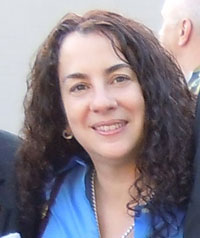'Lending circles' help low-income communities join the financial mainstream
Program helps low-income people build credit, reduce debt, SF State study shows
SAN FRANCISCO, June 4, 2013 -- An innovative financial lending program is helping low-income individuals build credit, reduce debt and find their financial footing, according to a pair of studies released today from San Francisco State University's César E. Chávez Institute (CCI).

Belinda Reyes, director of SF State’s Cesar E. Chavez Institute and associate professor of Latina/Latino studies.
Lending Circles, a program managed by the nonprofit Mission Asset Fund, dramatically improved credit scores for low-income residents of San Francisco, the studies found. In addition, the reports suggest the program can be successfully replicated in other communities and could serve as a nationwide model for helping vulnerable populations, particularly immigrants, achieve economic stability. Many of these communities were among the hardest hit by the recent recession.
"Low-income individuals, especially immigrant women, often have limited access to financial opportunities and few places to turn for help," said Belinda Reyes, an associate professor of Latina/Latino Studies at SF State, CCI director and lead author of the studies. "The Lending Circle program is bringing people who had no credit or very a damaged credit, into the financial mainstream."
In a lending circle, participants join a group of at least four individuals in which each contributes an equal amount and receives the total sum in rotation. For example, someone participating in a circle with seven other people could contribute $100 a month for 8 months in exchange for an $800 loan.
"This is something that immigrant communities in particular have used for generations," Reyes said. "In the past it has been very informal, but a good way of getting cash."
MAF is the first to formalize these types of peer loans by reporting payments to credit bureaus, allowing lending circle participants to build up credit. To build good spending habits, MAF combined the circles with financial education classes to help participants learn how to manage their expenses and adopt behaviors that can help their credit score. Researchers found that those who participated in a lending circle in 2011 and 2012 saw their credit score increase by an average of 168 points. The impact was even more dramatic for those with no credit history: 72 percent of participants with no credit score at the beginning of their lending circle had a score of 620 or above at the end of their first lending circle.
"The program is outstanding for people without credit history," Reyes said. "It really addresses the needs of those who are most in need."
The report also found lending circles helped participants reduce outstanding debt by an average of $1,000 versus a control group that increased its debt by an average of almost $3,000 over the same time period.
The impact of lending circles can be felt in the wider community as well, Reyes said. Many clients, for example, used their loan to expand an existing business, bringing an infusion of capital and entrepreneurship to vulnerable neighborhoods. The financial sector also benefits by gaining new customers who were previously unable to access traditional banking services.
"For the financial sector, there is this underground economy that they're not tapping into," Reyes said. "People are lending to each other informally and surviving every day without banking. Lending circles are a way of reaching these individuals in a way that is culturally relevant."
To see if the program could be successful elsewhere, CCI and MAF partnered with five Bay Area nonprofits to establish and study lending circles and found similar improvements in credit scores. These additional groups were more diverse than that at MAF, which serves primarily Latinos, showing the program can be replicated across different cultural communities.
The reports suggest that community-based organizations, particularly those that already have financial programs such as free tax preparation, job training or homeownership preparation, are ideal for implementing the program with the support of a central agency that secures the loans and handles loan processing, reporting and other administrative functions.
In all, MAF's Lending Circles program has been replicated in 16 communities across six states: California, Oregon, Nevada, Washington, Minnesota and Massachusetts.
###
"Building Credit for the Underbanked" and "Replicating Lending Circles" were authored by Reyes, Elías López, Sarah Phillips and Kurt Schroeder. To view the reports, visit http://cci.sfsu.edu/maf.
SF State is the only master's-level public university serving the counties of San Francisco, San Mateo and Marin. The University enrolls nearly 30,000 students each year and offers nationally acclaimed programs in a range of fields -- from creative writing, cinema and biology to history, broadcast and electronic communication arts, theatre arts and ethnic studies. The University’s more than 219,000 graduates have contributed to the economic, cultural and civic fabric of San Francisco and beyond.
The Mission Asset Fund, a nonprofit organization based in San Francisco, provides responsible financial products and services to ensure that low-income families have fair access to affordable credit and mainstream financial services.